- Know all about the southern campaign of Chhatrapati Shivaji Maharaj
(1676 to 1678). It included modern day Hyderabad, Vellore and parts of
Karnataka. Making Gingee Fort (TN) his third capital was an act of foresight,
this article tells why.
“With a success as happy as Caesar’s in Spain, he came, saw and overcame, and reported so vast a treasure in gold, diamonds, emeralds, rubies, and wrought coral that have strengthened his armies with very able sinews to prosecute his further victorious designs.” - Extract from a letter dated January
1678 from the English East India Company at Bombay (now Mumbai) to its
superiors in London, depicting the victorious campaign by Chhatrapati Shivaji
in Adilshahi Karnataka. (English Records on Shivaji-Vol II. Letter 272)
Note: All contemporary
documents mention the part as Adilshahi Karnataka (showing that the area was
ruled by Adilshahi of Bijapur when the area was liberated by Chhatrapati
Shivaji). This area is in modern day states of Karnataka and Tamil Nadu.
Background
of Dakshin Digvijaya campaign
Ekoji Raje, the stepbrother of
Chhatrapati Shivaji continued to serve with Adilshahi even after the death of
Shahaji Maharaj. In 1674-76, on the orders of Adilshah he defeated the Alagiri
Nayak and Chokkanath Nayak of Thanjavur but rather than handing over the throne
to the rival claimant of Nayak, he secured it for himself. So Raje started the Thanjavur Maratha kingdom. (Tanjavurche
Marathe Raje- Vakaskar-18-19)
Raghunathpant was one of the most
experienced ministers from the time of Shahji and was the chief advisor of
Ekoji. However, after a severe disagreement with Ekoji in early 1670s,
Raghunathpant left his job and came to the court of Chhatrapati Shivaji. He was
one of the most influential persons in the southern part of India and was
instrumental in planning the campaign of Dakshin
Digvijaya.
The
political situation in 1676
After the death of Ali Adil Shah II in
1672, his son Sikandar was crowned but since he was only five years old the
real power was in the hands of his ministers. This soon turned into a power
struggle between the Deccani faction led by Khawas Khan (Wazir) and the Pathan
faction led by Bahlol Khan (Commander-in-Chief). Though the internecine war had
destabilized Adilshahi, a campaign directed towards Bijapur (Adilshahi capital)
might have united the Adilshahi nobles.
Thus, Chhatrapati Shivaji should have faced stiff resistance and the campaign may have ended in failure like Mirza Raja Jai Singh’s in 1666-67. However, the southern part of Adilshahi kingdom was rich in resources, ill-defended and in chaos. The internecine war at Bijapur has spread even in this province with Sher Khan, (Governor of Southern Karnataka) a confidant of Bahlol, being on the warpath with Nasir Muhammad (Governor of Northern Karnataka), brother of Khawas Khan. (Memoirs of Francois Martin-Vol 1, Pg-38, 46).
Another reason to attack Adilshahi
Karnataka was to cut the lifeline of its military- the fine battle horses imported from the Middle-Eastern region.
When Chhatrapati Shivaji conquered the Western Coast up to Goa, it not only
deprived Adilshahi of its trade revenue but also of other imports, primarily
horses.
If Chhatrapati Shivaji could capture/
dominate the Eastern Sea coast then its resources would only boost the Swarajya. By depriving Adilshahi of its
most dependable, resource-rich region and blocking its supply of war horses,
Chhatrapati Shivaji wants to weaken its military and economic capabilities.
(Mehendale- Shivaji, his life & times- 855)
The third reason for liberating the
Adilshahi Karnataka was the strategic vision of Chhatrapati Shivaji about the
future Mughal-Maratha relations, details of which are in the summary segment of
this article.
The
primary moves
The major obstacle to planning this
campaign was the threat of a Mughal attack on Swarajya, hence Chhatrapati
Shivaji opened negotiations with Bahadur Khan (Mughal governor of Deccan) by
sending Niraji Raoji. Meanwhile, Aurangzeb had issued orders to Bahadur Khan to
lead an expedition against Bijapur, which helped Marathas greatly during the
negotiations. (Bhimsen-Tarikh-i-Dilkusha-107)
10 Bahadur Khan (Mughal Governor) Painting by Murad (1660-70)
As most of the top Mughal commanders had
failed to stop the Maratha liberation drive that started in 1670, they also
wanted a truce in which they could focus more on grabbing the territory of an already
weakened Bijapur. Niraji completed the negotiations successfully and signed a
non-aggression pact with Bahadur Khan.
Thus, in one stroke Chhatrapati Shivaji secured his borders as the Mughal forces on the western and northern borders of Swarajya were withdrawn by Bahadur Khan. This augmented Shivaji’s forces for the Bijapur expedition. Also, he made sure that in his long absence, the threat of Mughal invasion would force the Adilshahi to divert their resources to their northern borders, keeping their southern domains largely undefended. (Sabhasad-83-84, Bhimsen-111).
The second
masterstroke was a pact of friendship with Qutbshahi. Raghunath Pant had
already hinted about it and Pralhad Niraji the Maratha diplomat at Bhagyanagar (Hyderabad)
had discussed it with Madanna, the minister of Abul Hasan Tana Shah. They finalized
the preliminary terms. Two crucial issues, the siege train (common military
term for artillery, equipment and men required for siege) and maintaining supply
chain in this long campaign, were primarily tackled by this pact.
The Road to Bhagyanagar (Hyderabad)
On Dussehra (6th Oct 1676) the
Maratha army started its journey for the challenging campaign of Dakshin
Digvijaya. Through clever maneuvers the eventual destination of this mighty
force was kept secret from both the Mughals and Adilshahi. Rather than marching
directly towards Hyderabad which would take the army pretty close to Bijapur
and increase the possibility of a clash with Adilshahi, Maratha forces moved
from Raigad to Belgaum, next to Hubli and then entered Qutbshahi territory in a
long arch. However, one clash with the Bijapuri forces was unavoidable.
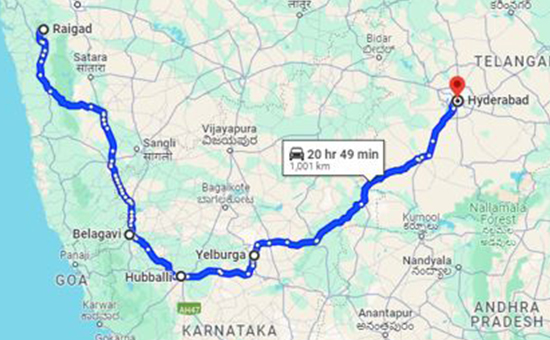 The route of Maratha forces from Raigad to Bhagyanagar.
The route of Maratha forces from Raigad to Bhagyanagar.
Battle
of YELBURGA
Gadag and the surrounding area were under the Miyana brothers (Adilshahi) who ruled from Koppal. When the Maratha army reached the area, Chhatrapati Shivaji ordered Hambirrao (C-in-C) to defeat Miyana brothers to secure the area which would later become a junction point towards the Southern possessions. In a bloody battle fought at Yelburga in January 1677, Hambirrao’s detachment killed Hussain Khan Miyana, captured his brother alive, and liberated the area from their tyranny. (Jedhe Shakavali, Shivcharitra Pradip-28).
When the Maratha army entered the Qutbshahi domain, special instructions were issued throughout ‘that the (Qutbshahi) citizens should not be harassed, and that supplies should be acquired from them amicably. Perfect discipline was ensured when a few miscreants were beheaded.’ This had the desired effect on Qutbshah and the population of the Bhagyanagar (Hyderabad), who welcomed Chhatrapati Shivaji in a grand celebratory manner. (Sabhasad-84-85) Note that Qutbshah is king’s name and Qutbshahi is kingdom name.
“The assembled citizens gave cheers for "Shiv Chhatrapati", flowers made of gold and silver were showered on him from the balconies crowded with ladies and the road-side alike. Now and then the women came forward and waved lighted lamps round his person with verses of welcome and blessing. In his turn, Shivaji also kept showering handfuls of gold and silver among the crowd …"
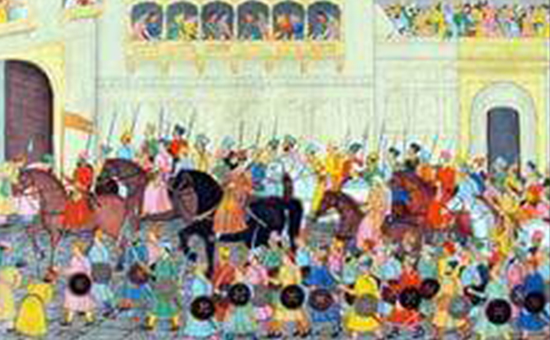 Shivaji enters Bhagyanagar (History of the Marathe Sardar Family FB page)
Shivaji enters Bhagyanagar (History of the Marathe Sardar Family FB page)
After the meeting, Qutbshah gave grand
gifts like elephants, fine horses, and jewels to Chhatrapati Shivaji and all
the Maratha nobles.
A treaty was finalized between these two
kings about the upcoming Karnataka campaign and the annual tribute that Qutbshah
would pay the Marathas. Qutbshah ordered his Prime Minister Madanna to ensure
all supplies to Chhatrapati Shivaji and to keep him happy. (Sabhasad-86).
The
climatic factor
According to renowned historian G.B.
Mehendale, Chhatrapati Shivaji had chosen the timetable of this campaign
carefully. By keeping his army near Adilshahi domains from October to March
which was a normal military campaign season in Deccan, especially on the
Western Coast, he had ensured that the former was in no position to attack
Swarajya.
However, the Coromandel (Eastern) Coast
receives most of its rainfall, from the northeast monsoon i.e. between October
to December. Hence, now the Maratha army was free to campaign in
Karnataka-Tamil Nadu from April to October 1677, whereas Adilshahi and Mughals
both had to suspend their operations from June to October due to heavy rains.
(Mehendale-Shivaji, his life and times-880)
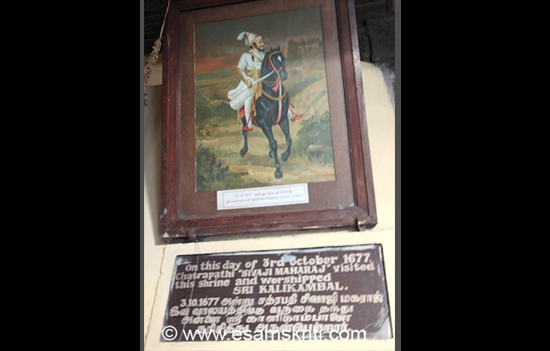 Shivaji Maharaj visited this temple in Chennai in October 1677.
Shivaji Maharaj visited this temple in Chennai in October 1677.
To see temple
album
Liberation
of Gingee
After taking darshana of Mallikarjun,
one of the 12 jyotirlingas at Srisailam, Chhatrapati Shivaji ordered the
construction of the northern entrance to the temple which is now known as
Shivaji Gopuram. Reference
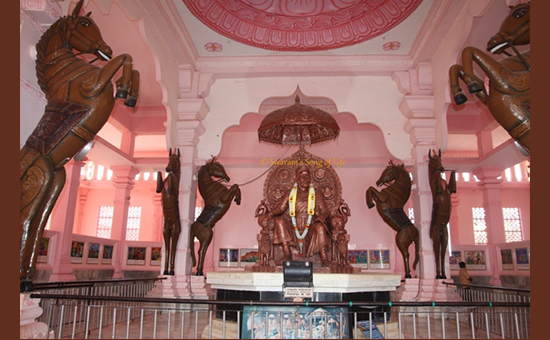 Shree Shivaji Spoorthy Kendra Srisailam.
Shree Shivaji Spoorthy Kendra Srisailam.
 Gingee Fort is close to Kanchipuram in modern day Tamil Nadu.
Gingee Fort is close to Kanchipuram in modern day Tamil Nadu.
The Maratha army then marched towards
Gingee and captured it through negotiations. Nasir Khan at Gingee had received
the news that not only Bahlol Khan has executed his brother Khawas Khan but
also usurped the position of Wazir at Bijapur. The situation in northern
Karnataka was made precarious by constant attacks from Sher Khan which would
now increase in frequency as Bahlol was supporting the latter.
So, Nasir Khan instead of resisting the
Marathas, opened negotiations and handed over the impregnable fort of Gingee in
May 1677. (Sabhasad-88)
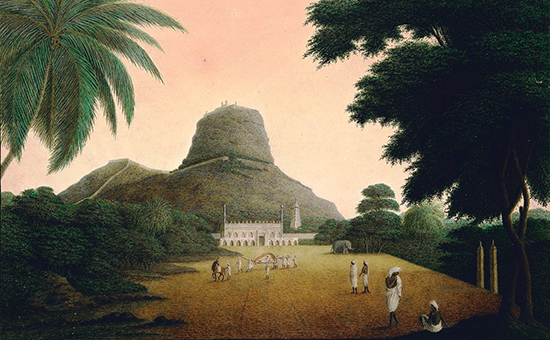 Gingee Fort (painting by Peter Anker 1744-1832) showing Kalyanmandapam and Rajgiri.
Gingee Fort (painting by Peter Anker 1744-1832) showing Kalyanmandapam and Rajgiri.
After capturing Gingee, one division of
the Maratha army went towards Vellore-
another impregnable fort. However, their attempt to negotiate the surrender of
the fort through Nasir Khan failed as Abdulla, the fort commander refused to
capitulate. Marathas had then no option but to start the siege with the help of
Qutbshahi siege train. The fort was captured after a siege of 14 months. (Martin-
94)
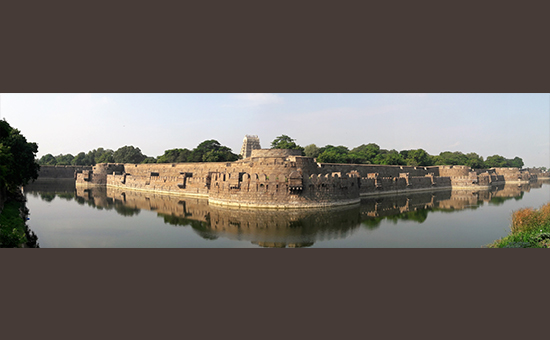 The Fort of Vellore by S Sriram.
The Fort of Vellore by S Sriram.
To see album of Fort of Vellore and Temples inside fort 2016
The fall of Gingee sent shockwaves
through the region and many major and small chieftains switched their
allegiance from Adilshahi to the Marathas. (Martin-97)
Campaign
against Sher Khan
After securing major forts and their
surrounding area in northern Karnataka, Chhatrapati Shivaji started his
campaign against Sher Khan, the Bijapuri governor of southern Karnataka.
Sher Khan’s military and supply position had considerably weakened after infighting with Nasir Khan. The infighting at Bijapur had compounded his problems. Neither was his forts stocked with garrison and supplies properly nor was his army ready to take on the Marathas. Martin describes ‘his troops numbered 3000 horses and 3 or 4000 infantrymen but the very name of Shivaji made them tremble’. (Martin-101)
Both, Sher Khan’s uncle and Martin (French Governor at Pondicherry) advised him to wait till the Marathas returned to their place and then strike against the remaining garrisons. But the political situation after the fall of Southern Karnataka in a whirlwind Maratha campaign forced Sher Khan’s hand.
Battle
of Thiruvadi
When he received news that around 6000
Marathas had reached near his headquarters at Thiruvadi, Sher Khan called out all
his forces for battle. But his ragtag army was no match for the Maratha force
and after a brief skirmish, Sher Khan ordered a retreat which instantly turned
into a rout due to lack of discipline.
With Maratha forces hot on his heels,
Sher Khan entered the forest of Akalnayak. Here a rearguard of 500 cavalrymen
fought with the Marathas for two hours giving Sher Khan time to escape with
only 100 horsemen. Marathas captured around 500 horses, 20 camels, 10-12
elephants, and several oxen as war booty. (English Records on Shivaji II-234,
Jedhe Chronology-28)
The Maratha cavalry chased Sher Khan so closely that he couldn’t make his retreat into the forest of Ariyalur as planned but had to take refuge at the Bhuvangiri Fort which was immediately besieged (29th June 1677). The rout of Sher Khan at the Battle of
Thiruvadi prompted his garrisons at several places like Valudavur,
Tevanampatnam, and many other forts to flee. These forts then were promptly
garrisoned by the Marathas. (Martin-103)
Sher Khan couldn’t resist any longer as his army morale took a severe beating. He surrendered on July 7 wherein he had to cede all his possessions permanently to the Marathas and pay 20000 hons (golden coins) as war indemnity. His son remained as a hostage till these conditions were fulfilled. He was released in February 1678. (Martin-106-7)
Abolition
of Slavery- A Revolution on the Coromandel Coast
Most of the Islamic and Western powers
operating in India were practicing slavery and used to traffic primarily Asian
and African subjects as slaves. Chhatrapati Shivaji
was strictly against slavery. So the areas which he liberated in Karnataka-Tamil Nadu were then treated as a part of Swarajya. Hence while issuing his ‘kaul’ (letter for operating on the Coromandel coast) to the Dutch factor in August 1677, Chhatrapati Shivaji confirmed all the old rights of the Dutch except the right to buy and transport slaves.
Considering that slavery was practiced
on an extensive scale in that era, this step of Chhatrapati Shivaji was truly
revolutionary. (Xenophobia-175-76)
Restoration of destroyed temples
When Adilshahi won Gingee, Vellore, and
surrounding areas from the Hindu kings of Vijayanagar, many of the temples were
destroyed or converted into mosques in the 1650s. According to the contemporary
Tamil-French chronicle, when Chhatrapati Shivaji liberated the area from the
clutches of Adilshahi, he received a petition from the citizens about two temples converted into mosques, a Shiv Temple and
Samuthira Perumal (Vaishnava) in Tiruvannamalai (around 40km from Gingee). He
ordered the destruction of these mosques which were deliberately built atop
Hindu temples and reconsecrated the respective temples.
He also instructed to restart the Kartik Deepam- a tradition of lighting
clay oil lamps to ward off evil and welcome prosperity on the night of Kartik
Purnima in temples which was discontinued earlier due to their destruction.
The restoration of these temples created ripples across the region and sent a strong message that the deliberate destruction of Hindu religious places would not be tolerated. Hindus now had the backing of political and military power that could restore these temples. Energized by this, the servants appointed in these two temples carried the message across the regions wherever the temples had been demolished and helped in their reconsecration. (Histoire Détaillée Des Rois Du Carnatic- Narayanampoullé- Translated by M. Snanou Diagou, Pg-71)
Meeting
with step-brother Ekoji Raje
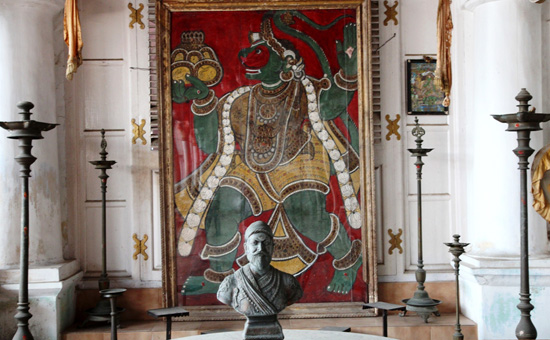 Shivaji bust in modern day Thanjavur Palace.
Shivaji bust in modern day Thanjavur Palace.
When Chhatrapati Shivaji wrote to his stepbrother about the division of late Shahaji Raje’s fief, Ekoji Raje came to his camp at Thirumalapadi on the Coleroon River with his retinue. Their first meeting in over 30 years happened in a cordial atmosphere but when the discussion started about dividing the fief Ekoji was reluctant to divide the fief. His courtiers like Kakajipant, Niloba Naik, were in favor of settling the matter amicably and advised their master accordingly but Ekoji failed to listen to their wise counsel. After a week of meetings and negotiations failed to resolve the issue, Ekoji started fearing arrest and left the camp secretly for Thanjavur.
Chhatrapati Shivaji became angry at such irresponsible behavior of Ekoji as he would never think of imprisoning his stepbrother. The Ekoji’s courtiers who were detained after the formers escape were quickly released and sent back to Thanjavur as a gesture of goodwill, but Chhatrapati Shivaji decided to teach a lesson to Ekoji and accordingly ordered the army to capture his possessions. Maratha forces
soon annexed areas like Jagdevgad, Chidambaram, Vriddhachalam.
(Tanjavurche Maratha Raje- Annexture 4-Pg-297-300, Jedhe Chronology-28)
Chhatrapati Shivaji then left with half
the army for Maharashtra in Sept-Oct 1677. While returning his force captured
areas like Kolar, Banglore, Hoskote, Balapur, etc. Friendly relations were
established with many of the small kingdoms like Keladi, Chitradurga, Sondha,
Bednur, etc.
After Chhatrapati Shivaji left for Maharashtra, Ekoji tried to recapture this area but Maratha forces under Hambirrao, Santaji Bhosale, and Raghunathpant decisively defeated him at the battle of Valikandpuram in November 1677 and captured immense war booty. When the news reached Chhatrapati Shivaji he instructed his nobles not to annex Ekoji’s domains completely. Raghunathpant then signed a peace treaty with Ekoji for permanent settlement of borders and then Hambirrao also left for Maharashtra. (Jedhe Chronolgy-29)
Setting
up the Administration
The liberation of a place is useless unless a civil administration is effectively ruling the place. Chhatrapati Shivaji had already planned to overhaul the administration of the newly liberated territories. Hence as soon as the Maratha army won any area, a civil administration unit would take the place of the earlier administration, this case from Adilshahi. In July 1677 Martin confirms that ‘two brahmins sent by Shivaji reached Pondicherry for governing this area’ and ‘he (Chhatrapati Shivaji) sent brahmins to all the areas of the country to govern them’. (Martin 108-9)
Chhatrapati Shivaji appointed Raghunathpant
who was of invaluable help in planning Daikshin Digvijaya campaign as governor
of these territories and rewarded him by giving 1lakh gold Hons. The total
revenue from the liberated area was estimated as 20lakh gold hons and 10,000
new troops were enlisted in the Maratha army for the defense of it by
Raghunathpant. (Sabhasad-90, Jedhe-29)
Many of the small and inconsequential
posts and forts were demolished in the region and new forts were constructed on
the strategic hilltops and places.
The Gingee
Fort which was considered of prime importance in the larger scheme of strategic depth and its defenses was strengthened by demolishing some parts of earlier fortifications and completely rebuilding it. Andre Freire jealously notes about the reconstructed Gingee fort. ‘He constructed new ramparts around Gingee, dug ditches, erected towers, created basins, and executed all these works with a perfection which European art would not have denied.’ (R. Satyanatha Aiyar-History of the Nayakas of Madura-283-84)
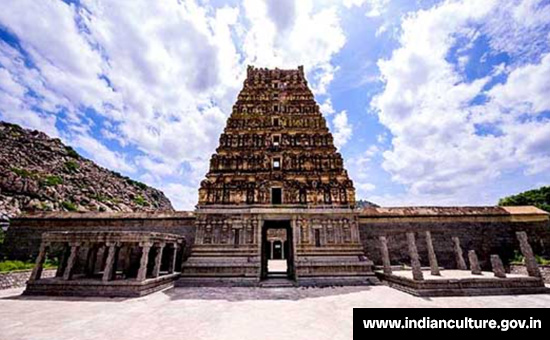 Venkataswami Temple.
Venkataswami Temple.  Kalyana Mahal.
Kalyana Mahal.
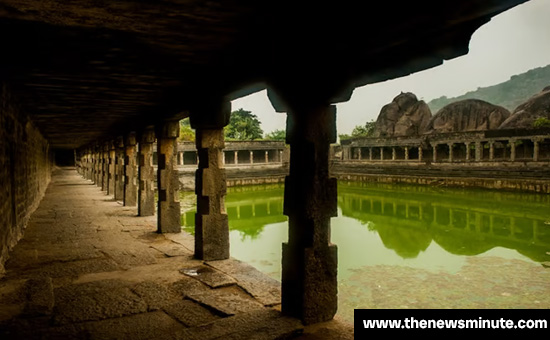 Temple tank.
Temple tank.
 Throne on the Krishnagiri – British Library
Throne on the Krishnagiri – British Library
Importance
of Dakshin Digvijaya
As discussed earlier the liberation of the Southern part of India, which was a lifeline of revenue for Adilshahi, was a primary goal. It also gave strategic depth to the Swarajya as it was now first in the line of fire in Aurangzeb’s expansionist policies. Though the intended Mughal invasion came after the death of Chattrapati Shivaji, the foundation for countering it had already been laid in this campaign.
During the 27 years war when Aurangzeb’s forces and natural calamities were ravaging the Swarajya, the grain and revenue stream from this yet unmolested part was crucial in sustaining the resistance.
When Chhatrapati Sambhaji was captured
and Raigad, the Capital besieged, Yesubai and the Maratha Ashtapradhan Mandal
decided to transfer Rajaram Maharaj to Gingee for his protection. This changed the epicenter of the operations from
Maharashtra to Gingee which became the third Capital of Swarajya after Rajgad
and Raigad. This forced Aurangzeb to send a large part of his army to
besiege it and another major portion of his army to multiple outposts to guard
its supply chain. The Mughal forces were so stretched in vast areas that they became
vulnerable to constant attacks from the Marathas and its allied forces.
The efforts to make Gingee impregnable
bore fruit now as the fort withstood siege by Zulfikar Khan for close to 8
years - one of the longest-running sieges in human history. This costly siege
not only drained much of the men, money, and materials but also the morale of
the Mughal army. Read Santaji Ghorpade and the Battle of Dodderi – Defeat of the Mughals
The importance of establishing friendly
relations with small southern kingdoms was truly realized in this war. When
Rajaram Maharaj was moving incognito from Panhala to Gingee and Mughal forces
were chasing him, Chenamma- the queen of Keladi
helped him to pass through her territory despite Mughal threats. The
Maratha allies like Brahmappa Nayak (Chitradurga), Pidiya Nayak (Wakinkhera),
Yachappa Nayak (Venkatagiri) gave timely help to Marathas during this phase,
the siege of Gingee and the battle of Dodderi are prime examples of this
collaboration.
 Keladi Chenamma and Chhatrapati Rajaram (Rameshwaram Temple, Keladi)
Keladi Chenamma and Chhatrapati Rajaram (Rameshwaram Temple, Keladi)
In summary, the Dakshin Digvijaya campaign was a clear indication of the
farsightedness and strategic planning of Chhatrapati Shivaji.
The area liberated in this campaign not only helped Marathas sustain in crucial times but also helped them attack and defeat Mughal forces over a vast area from today’s Maharashtra to Tamil Nadu at a point of their choosing.
Thus, the
seeds for the destruction of the Mughal Empire and the foundation of the
Maratha Empire- an indigenous Empire that ruled large parts of the Indian
subcontinent in the 18th Century are in this campaign.
To read all
articles by author
To read all
articles on Maratha History
To read all
articles on Indian History
Also
read
1. Gingee
Fort Citadel
2. The Formidable Gingee Fort
3. Gingee Fort – Troy of the East
4.
Sivaji performed ‘Upavasa Deeksha’ at Sangameswaram”
5.
Excerpt from Vaibhav Pursandhare book – The kind of State Shivjai was trying to establish